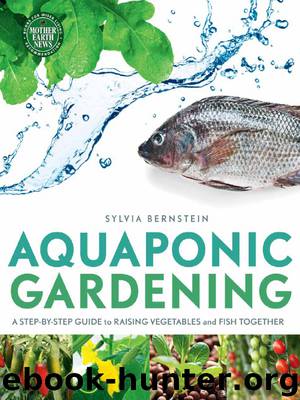Aquaponic Gardening by Sylvia Bernstein

Author:Sylvia Bernstein
Language: eng
Format: epub
Tags: GAR022000, TEC049000
ISBN: 9781550924893
Publisher: New Society Publishers
Published: 2011-09-30T16:00:00+00:00
Biofilter for the solid waste
In media-based aquaponics, the solid waste from the fish is pumped into the grow beds along with the liquid waste. This is then broken down by heterotrophic, aerobic bacteria as well as the composting worms you add to your bed. Your plants will appreciate and thrive on the additional nutrients.
Home for worms
An aquaponic media bed that your system floods and drains with fish waste becomes an ideal environment for a thriving composting worm population.
Air and water exchange
The porosity of your grow media and the spaces among the media hold air and water between flood cycles that are vital to the health of your plants.
Temperature moderation
The media acts as a blanket around the roots of your plants, protecting them from rapid fluctuations in temperature.
What is the best medium?
Most people use either gravel or expanded clay (Hydroton®) for their media and both are widely available. Expanded shale is a media type that is quickly gaining popularity. It has many of the wonderful properties of expanded clay, including being highly porous and lightweight, but is domestically produced and less expensive. In addition, there may be other candidates, depending on availability in your area (see the table below).
Here are some “must-haves” and “nice-to-haves” for you to consider when you select your aquaponic media.
Expanded shale.
Download
This site does not store any files on its server. We only index and link to content provided by other sites. Please contact the content providers to delete copyright contents if any and email us, we'll remove relevant links or contents immediately.
| Fisheries & Aquaculture | Forests & Forestry |
The Lonely City by Olivia Laing(4120)
Animal Frequency by Melissa Alvarez(3755)
All Creatures Great and Small by James Herriot(3516)
Walking by Henry David Thoreau(3234)
Exit West by Mohsin Hamid(3183)
Origin Story: A Big History of Everything by David Christian(3139)
COSMOS by Carl Sagan(2950)
How to Read Water: Clues and Patterns from Puddles to the Sea (Natural Navigation) by Tristan Gooley(2855)
Hedgerow by John Wright(2776)
The Inner Life of Animals by Peter Wohlleben(2766)
Origin Story by David Christian(2683)
How to Read Nature by Tristan Gooley(2665)
Project Animal Farm: An Accidental Journey into the Secret World of Farming and the Truth About Our Food by Sonia Faruqi(2661)
How to Do Nothing by Jenny Odell(2645)
A Forest Journey by John Perlin(2587)
Water by Ian Miller(2584)
The Plant Messiah by Carlos Magdalena(2453)
A Wilder Time by William E. Glassley(2363)
Forests: A Very Short Introduction by Jaboury Ghazoul(2335)
